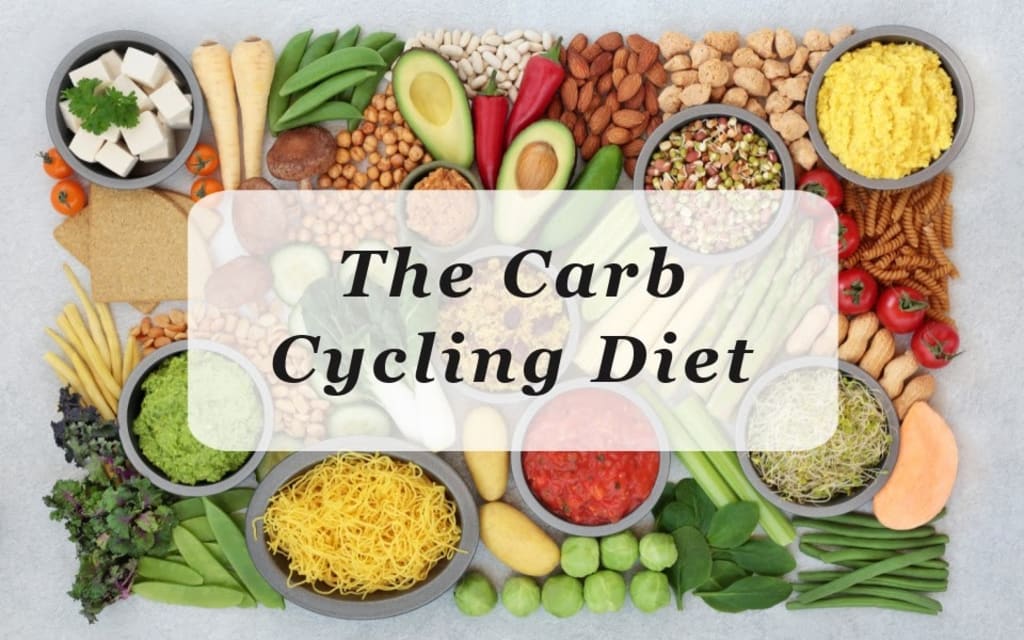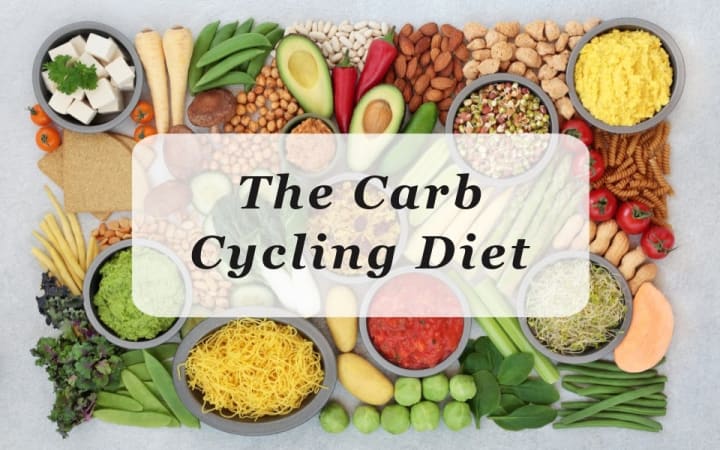Content warning
This story may contain sensitive material or discuss topics that some readers may find distressing. Reader discretion is advised. The views and opinions expressed in this story are those of the author and do not necessarily reflect the official policy or position of Vocal.
Carb Cycling For Weight Loss
Carb Cycling Meal Plan—What Is It? Does It Work

Weight Loss

In This Article
What Is Carb Cycling?
What Does the Science Say About Carb Cycling?
Benefits of Carb Cycling
Drawbacks of Carb Cycling
Is Carb Cycling Ketogenic?
What Should You Eat If You're Carb Cycling?
5-Day Carb-Cycling Meal Plan
What Is Carb Cycling?
Carb cycling, also known as the intermittent low-carb diet, is a method of eating carbohydrates in which you alternate how many carbs you eat each day—high, moderate or low—based on your workouts and long-term goals. The thinking is that your low-carb days put you in a fat-burning state and eating high-carb boosts your metabolism.
carbohydrates are the body's main and preferred source of energy. Low-carb diets have long been followed for weight loss, and research shows that compared to low-fat diets,low.carbohydrate diets can lead to greater weight loss in the short term. The caveat is that low-carb diets are difficult for most people to follow long-term.
It's also tough to eat low-carb if you exercise frequently, and low-carb diets are difficult for endurance athletes and bodybuilders who rely on carbohydrates to fuel their workouts. Carb cycling may be a solution for elite athletes where they can alternate carbs based on their training schedule. It's also becoming a popular strategy for those trying to lose fat or get past a weight-loss plateau while still staying active
What Does the Science Say About Carb Cycling?
Unfortunately, not much. There aren't many controlled studies directly investigating carb cycling. The thinking behind carb cycling comes from other weight-loss approaches—like calorie restriction and the Ketogenic diet.combined with the science around fueling workouts and burning fat.
Carb cycling tries to match the body's need for glucose. If you've got a longer, more intense workout or race, you need more carbs beforehand (i.e., "carb loading"). If it's a rest day, then not so much. The rationale behind carb cycling is that you don't need as many carbohydrates on the days you aren't racing or doing an intense workout, so you can cut back on carbs on these days while keeping protein and fat about the same or eating a little more fat.
Benefits of Carb Cycling
1. Improved Fat Burning
As with any diet restricting calories, you may notice weight loss in the short term but little to no progress as time passes, meaning you may have hit the plateau in your weight loss journey. The thought is that when you are in a calorie-deficit state, your hormones signal your body to find new ways to minimize weight loss, according to a 2019 study in Sports. Specifically, leptin, the hormone that regulates appetite and calorie expenditure, comes into play. When low levels of leptin are present, this signals to the brain that you are not getting enough calories, resulting in a chain of physiological changes, such as eating more food and burning fewer calories. This new metabolic state is known as adaptive thermogenesis.
The idea behind carb cycling is to prevent the body from adapting to this new metabolic state. In other words, the leptin levels are increased temporarily on days when you have a larger intake of carbs, which may improve metabolism and the body's ability to burn fat as fuel in the long term. However, more research is needed to further investigate the relationship between carb cycling and leptin levels.
2. Stronger Muscles
Glycogen, the storage form of carbs, is stored in the muscles and the liver as a quick form of energy when needed. When you are on low-carb days during carb cycling, there is limited storage of glycogen. So, the high-carb days (also called "re-feeding") are in place to refuel muscle glycogen, which may improve performance and reduce muscle breakdown.
3. Better Blood Sugar
Another big component of carb cycling is how it affects insulin. A high-carb diet may lead to more spikes in blood sugar levels, so having low-carb days and targeting carbs around the workout may improve insulin sensitivity. This approach may help maximize the benefits that carbohydrates provide.
Drawbacks of Carb Cycling
1. May Go Overboard with Carbs
A carb cycling diet is not easy, and some argue that it should be reserved for elite endurance athletes rather than just anyone trying to lose weight. That's because it's difficult to know how many carbohydrates to take in on low-, moderate- and high-carbohydrate days. Some low-carb days have about 2½ to 5 servings of carbs, while high-carb days have 10 to 20 servings. It's also time-consuming because you have to track carbohydrates, protein and fat. You could fall off track if you do not track your carb intake carefully.

2. May Develop an Unhealthy Relationship with Food
While carb cycling may be doable in the short term, maintaining this way of eating may be challenging in the long run. As with any diet, there's also the risk of developing an unhealthy relationship with food. On low-carb days you might find yourself craving high-carb foods throughout the day, and then when your high-carb day comes around, there's a risk that you may binge on them. Also, this diet doesn't take an individual's appetite into consideration. Some people find that on heavy training days, they don't have as much appetite as on rest days. And trying to eat super-low-carb on a day when you have a larger appetite is not sustainable.
Is Carb Cycling Ketogenic?
A carb-cycling diet is not the same as a ketogenic diet. The ketogenic diet limits carbohydrates to 20 to 40 grams each day in order to keep the body in a state of ketosis, where it burns fat for energy instead of carbohydrates. In contrast, carb cycling alternates the number of carbs eaten each day. You can't follow both diets simultaneously because, on a high-carb day, you would throw your body out of ketosis.
5-Day Carb-Cycling Meal Plan
Day 1: Rest day, low carbs (30-50 grams)
Breakfast: Muffin-Tin Omelets with Feta & Peppers (7 g carbs)
Lunch: Spinach & Artichoke Salad with Parmesan Vinaigrette (12 g carbs)
Dinner: One-Skillet Chicken Paprikash with Mushrooms & Onions over riced cauliflower (12 g carbs)
Snacks: 1 slice Cheddar cheese, 1 cup raspberries (6 to 8 g carbs)
Day 2: Moderate workout, moderate carbs (100 grams)
Breakfast: Apple-Cinnamon Overnight Oats (41 g carbs)
Lunch: Chile-Lime Turkey & Spaghetti Squash Meal-Prep Bowls (25 g carbs)
Dinner: Salmon with Curried Yogurt & Cucumber Salad over 1/2 cup cooked brown rice (30 g carbs)
Snacks: 1 slice Cheddar cheese, 1 cup raspberries (6 to 8 g carbs)
Day 3: Intense workout, high carbs (200 grams)
Breakfast: Gingerbread Buttermilk Pancakes topped with one medium banana and 2 tablespoons maple syrup (104 g carbs)
Lunch: Veggie & Hummus Sandwich (40 g carbs)
Dinner: Pesto Ravioli with Spinach & Tomatoes (35 g carbs)
Snacks: 1/4 cup almonds, 1 slice Cheddar cheese, 1/2 cup raspberries (15 to 18 g carbs)
Day 4: Moderate workout, moderate carbs (100 grams)
Breakfast: Apple-Cinnamon Overnight Oats (41 g carbs)
Lunch: Chile-Lime Turkey & Spaghetti Squash Meal-Prep Bowls (25 g carbs)
Dinner: Sheet-Pan Sesame Chicken & Broccoli with Scallion-Ginger Sauce over 1/2 cup cooked brown rice (34 g carbs)
Snacks: 1 slice Cheddar cheese, 1 cup raspberries (6 to 8 g carbs)
Day 5: Rest day, low carbs (30-50 grams)
Breakfast: Muffin-Tin Omelets with Feta & Peppers (7 g carbs)
Lunch: Spinach & Artichoke Salad with Parmesan Vinaigrette (12 g carbs)
Dinner: Shrimp Cauliflower Fried Rice (10 g carbs)
Snacks: 1 slice Cheddar cheese, 1 cup raspberries (6 to 8 g carbs)
On high-carb days, keep the carbs healthy. Skip refined, sugary foods and go for whole foods like sweet potatoes, oatmeal, whole-wheat bread, brown rice, fruit and quinoa. These starches are high in fiber and have a more complex carbohydrate structure, requiring your body to burn a bit more energy to break them down. Choose lean protein sources such as chicken, turkey, eggs, fish, nuts, seeds, legumes and soy products.
On low-carb days, limit fruits and starchy vegetables. You can still eat low-carbohydrate vegetables like leafy greens, eggplant, tomatoes, broccoli, peppers, cauliflower and avocados. You should also aim to get plenty of protein, as well as healthy fats like olive oil, nuts, seeds and fatty fish.
The Bottom Line
The carb cycling diet is an eating plan used in the short term by endurance athletes and bodybuilders to alternate carbohydrate intake based on the intensity and duration of workouts. It can also be followed by people who want to eat low-carb for fat loss but still remain active. Work with a registered dietitian to determine how many carbohydrates to eat each day based on your workout schedule, and keep in mind that studies are lacking on the long-term efficacy of carb cycling
About the Creator
Oliver
Hi, I'm Manoj Soni ! I am a WordPress developer ,Affiliate marketing
i will create Automated Travel Marketing Website using travel payout
Hello, Business Builders.
Enjoyed the story? Support the Creator.
Subscribe for free to receive all their stories in your feed. You could also pledge your support or give them a one-off tip, letting them know you appreciate their work.






Comments
There are no comments for this story
Be the first to respond and start the conversation.